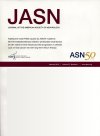Genotype-Based Molecular Mechanisms in Alport Syndrome
 Alport syndrome is an inherited disorder characterized by kidney disease, sensorineural hearing loss, and ocular abnormalities. Alport syndrome is caused by pathogenic variants in COL4A3, COL4A4, or COL4A5, which encode the α3, α4, and α5 chains of type 4 collagen that forms a heterotrimer expressed in the glomerular basement membrane. Knowledge of its genetic basis has informed the development of different models in dogs, mice, and rats that reflect its autosomal and X-linked inheritance patterns as well as different mutation types, including protein-truncating and missense variants. A key difference between these two types is the synthesis of α3α4α5(IV), which is not made in autosomal Alport syndrome (two pathogenic variants in trans or biallelic) or male patients with X-linked Alport syndrome due to protein-truncating variants. By contrast, α3α4α5(IV) is synthesized in Alport syndrome because of missense variants. For missense variants, in vitro studies suggest that these cause impaired type 4 collagen trafficking and endoplasmic reticulum stress. For protein-truncating variants, knockout models suggest that persistence of an immature α1α1α2(IV) network is associated with biomechanical strain, which activates endothelin-A receptors leading to mesangial filopodia formation. Moreover, studies suggest that activation of collagen receptors, integrins and discoidin domain receptor 1, play a role in disease propagation. In this review, we provide an overview of how these genotype–phenotype mechanisms are key for a precision medicine–based approach in the future.
Alport syndrome is an inherited disorder characterized by kidney disease, sensorineural hearing loss, and ocular abnormalities. Alport syndrome is caused by pathogenic variants in COL4A3, COL4A4, or COL4A5, which encode the α3, α4, and α5 chains of type 4 collagen that forms a heterotrimer expressed in the glomerular basement membrane. Knowledge of its genetic basis has informed the development of different models in dogs, mice, and rats that reflect its autosomal and X-linked inheritance patterns as well as different mutation types, including protein-truncating and missense variants. A key difference between these two types is the synthesis of α3α4α5(IV), which is not made in autosomal Alport syndrome (two pathogenic variants in trans or biallelic) or male patients with X-linked Alport syndrome due to protein-truncating variants. By contrast, α3α4α5(IV) is synthesized in Alport syndrome because of missense variants. For missense variants, in vitro studies suggest that these cause impaired type 4 collagen trafficking and endoplasmic reticulum stress. For protein-truncating variants, knockout models suggest that persistence of an immature α1α1α2(IV) network is associated with biomechanical strain, which activates endothelin-A receptors leading to mesangial filopodia formation. Moreover, studies suggest that activation of collagen receptors, integrins and discoidin domain receptor 1, play a role in disease propagation. In this review, we provide an overview of how these genotype–phenotype mechanisms are key for a precision medicine–based approach in the future.



